William C. C. Chen Teaches How to Punch - Videos
Tai Chi master reveals secrets of fast, effective punching
Channel:
Essential Sports and Fitness Videos (Tai Chi)
Grandmaster Chen's specialty is teaching the connection between the Tai Chi movements and achieving great
speed and power for self defense.
He has trained world-champion martial artists, police, military hand-to-hand combat instructors, and professional boxers.
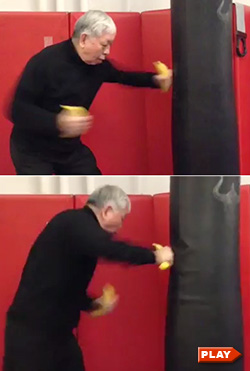
Punching Holding a Banana and with an Open Hand
The fist never needs to be clenched for a strong punch. (00:00:20)
This is a clip of Grandmaster William C. C. Chen hitting a punching bag while holding a banana in each hand.
He proves that the fist never needs to be clenched, either while doing the Tai Chi form or while strking.
By punching a padded wall with his open hand, he shows that the knuckles receive the shock without injury, and demonstrates
that a relaxed punch gives the greatest speed, as well as power.
(Demonstration at age 81.)
From: KungFuMagazine.com (c) 2014, used with permission
To watch Grandmaster Chen's demo, click on picture
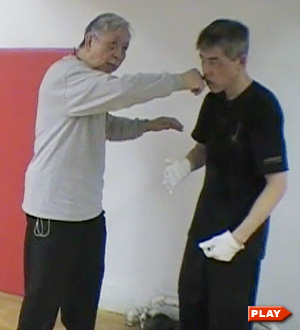
How to do a Fast Punch
Don't clench your fist. (00:08:23)
Grandmaster Chen explains and shows why the fingers of the fist should be left open,
with the knuckles delivering the punch.
As an exercise, pretend that your fingers are hiding a secret written on the target. Don't push in.
Clenching slows you down and is not necessary to protect the hand.
He illustrates the "one-inch punch" and rapid strikes from a close distance, which requires
proper alignment of the fingers, knee, and toes plus a focus on alternating use of the fingers both for the strikes
(thumb and first two digits) and for releasing the leg muscles between them (using the pinky finger).
(Applications class, 2009.)
From: William C. C. Chen
To watch Grandmaster Chen's class, click on picture

Boxing Class (2002)
Basic punches, blocks, and combinations with the Tai Chi feeling. (00:10:37)
This episode of Sam Masich's Taiji People series follows Master Chen through a boxing class, with plenty of examples
of his punching speed and power.
He demonstrates the connection between Tai Chi principles and basic punch and blocking combinations.
Power comes from the base, not the arms. The body stays loose, without tension.
We see him giving instruction to his children, martial arts champions, Tiffany and Max, as well as U.S. and world push hands champion, Josh Waitzkin.
From: William C. C. Chen and Sam Masich
To watch Grandmaster Chen's boxing lesson, click on picture
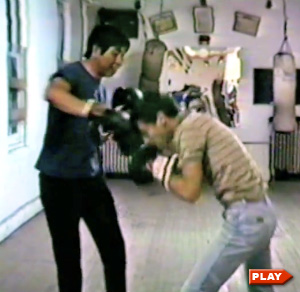
Private Boxing Lesson
Relaxed, smooth use of the body. (00:12:29)
A rare video of Grandmaster Chen sparring with one of his students, showing how Tai Chi softness, smoothness, and relaxation
can be effectively applied to boxing. (NYC, late 1970's or early 1980's)
His training technique emphasizes light, relaxed, slipping of punches and fast counter-punching,
as opposed to blocking and throwing powerhouse shots. To succeed at relaxation and maintaining a light touch, he would often leave himself open
to being hit and encouraged his students to do the same. (VHS tape)
From: William C. C. Chen
To watch Grandmaster Chen's boxing lesson, click on picture
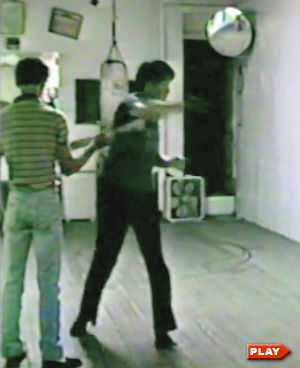
Double Punch Lesson
Achieving speed and power. (00:04:42)
We see Grandmaster Chen teaching one of his favorites, a double right-cross. The first punch is a fake to the belly, followed
by a fast, powerful punch to the head. (NYC, late 1970's or early 1980's)
He uses a rolled-up newspaper as the target and shows how to move from the bottom to the top of the roll
with amazing speed and power. (VHS tape)
From: William C. C. Chen
To watch Grandmaster Chen's boxing lesson, click on picture
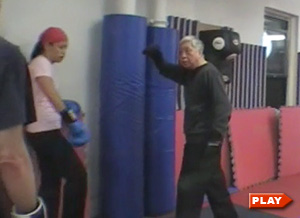
Demonstration of a Few Hard Punches
The fist takes the shock. (00:00:16)
Grandmaster Chen throws some hard punches to illustrate that the knuckles are taking the shocks and the body
is doing the punching.
That is, it's best to think of the fist's role as just receiving the force instead of participating
in its creation.
(San shou class, 2010. Master Chen was 78 at the time.)
From: William C. C. Chen
To watch Grandmaster Chen's class, click on picture
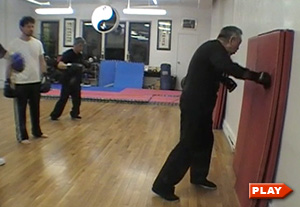
How to get the Most Power in a Punch
Empty the chest. Stay loose. Don't push. (00:04:20)
Grandmaster Chen explains that the most effective punches use the lower abdomen (tan t'ien) and the inner thigh.
Try pretending that you have a broken arm with a cast and so can't use your arms.
Think of punching, unlike breaking a wall, as being like playing the drums, where playing louder yields more power.
(San shou class, 2009)
From: William C. C. Chen
To watch Grandmaster Chen's class, click on picture

Television Demo of Tai Chi Principles and Punches
What's the difference between Tai Chi for exercise and Tai Chi Chuan? (00:10:42)
We see a short clip of Michelle Obama doing Tai Chi in China, and then Grandmaster William C. C. Chen discusses
the principles of relaxation, flow, and energizing the fingers in the Tai Chi form.
The interview gets pretty hilarious as he shows that Tai Chi is more than a health exercize and is a practical
martial art. He explains that avoiding muscular tension leads to great speed and demonstrates by holding a banana
that the fist does not need to be clenched to deliver an effective punch. (Recorded 2014-03-27.)
From: William C. C. Chen and Arise TV
To watch Grandmaster Chen's interview, click on picture
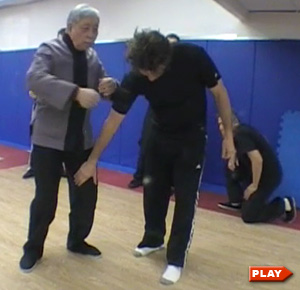
The Connection between Punching and Tai Chi Principles
Sink down, relax, use your toe to spin your fingers. (00:10:56)
Grandmaster Chen explains and demonstrates the difference between using internal "compression" energy versus muscle power for punching.
He compares chi to "pumping air in a tire".
He talks about the how energy is transmitted from the toe and leg muscles to the fingers.
He starts with images: you "get ready to jump" and then "jump your fingers".
Your toe drives in, spinning the fingers, with the
body following. Meet the resistance without pushing in.
(San shou class, 2010)
From: William C. C. Chen
To watch Grandmaster Chen's class, click on picture
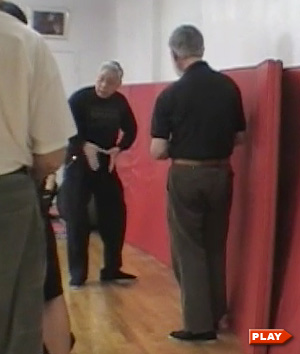
How to do Fast Punches
The body stays loose and follows. (00:01:08)
To speed up punches, Grandmaster Chen recommends against thinking too much about the punch as a strike. Focus on
keeping the body loose and following the hand, rather than the body leading the hand.
The axis that the body turns on is in one hip
or the other, not both, so don't try to turn both hips in unison.
(Workshop, 2009)
From: William C. C. Chen
To watch Grandmaster Chen's class, click on picture
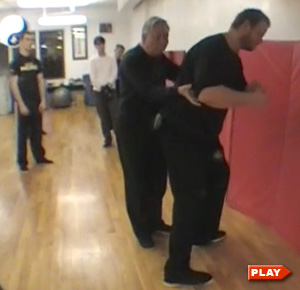
How to do a Powerful Punch
Stay loose and maintain "gorilla shape" no matter how hard you punch. (00:04:40)
Grandmaster Chen uses the image of serving coffee and tea in a relaxed manner to convey the body shape needed to deliver power
while protecting the shoulder.
He discusses the similarity of the shape made for a punch with the shapes made in the Tai Chi form, such as the "ward-off" movement.
He shows adjusting the position to protect from kick attacks and demonstrates rapid alternating between
low and high punches. The toe spins you in. Don't push out.
(San shou class, 2009)
From: William C. C. Chen
To watch Grandmaster Chen's class, click on picture
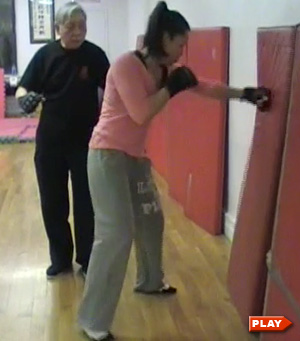
How to Jab with Power
Don't push. Expand from the ground. (00:07:05)
Grandmaster Chen corrects the jabs of his students. Here he is training his daughter Tiffany.
Don't push into the target, and don't turn the hips.
Expand from the ground, "walk up", like marching in a parade.
Put your foot down first and use the toe and the ball of the foot to push the knuckles out, making a solid popping sound at the target.
If you don't pull all the way back, you create the possibility of doing another, faster jab.
If you do pull back, your elbow doesn't need to stay up and you can get some extra protection.
(San shou class, 2009)
From: William C. C. Chen
To watch Grandmaster Chen's class, click on picture
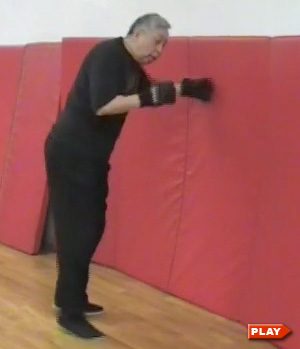
How to do Fast and Hard Uppercuts and Jabs
Keep arm and body loose and step up. (00:02:52)
Grandmaster Chen demonstrates and offers advice on doing fast jabs.
Imagine you are catching something that's dropped. Spin the fingers and just get there.
For power, don't step down when you punch. Instead, "step up".
A light punch is like carrying an empty shopping bag, and it can get heavier and heavier.
Finally, he shows the position needed to protect from kicks and body shots without loosing the power of the punch.
(Application workshop, 2009)
From: William C. C. Chen
To watch Grandmaster Chen's class, click on picture
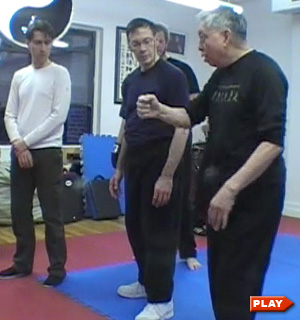
How to do High Speed Uppercuts, Jabs, and Cross Punches
Don't stop your punch. Just get there. (00:04:34)
Grandmaster Chen teaches students to do high speed punches.
Don't stop your punch or squeeze your fist. Just get there and stay there. The body knows how to take the power
The toe is involved in generating the punch, but the leg doesn't need to move.
The two hands work together and support each other. Don't think about one hand at a time.
(Application workshop, 2009)
From: William C. C. Chen
To watch Grandmaster Chen's class, click on picture
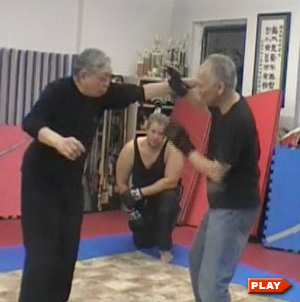
How to do Effective Hooks
Open up the hip. (00:00:38)
To help students understand the body mechanics of the hook, Grandmaster Chen slows down the action.
To set up the hook, you must wind up your hip, opening up the space between the chest wall and the elbow.
Don't wind up the whole body.
(Application class, 2010)
From: William C. C. Chen
To watch Grandmaster Chen's class, click on picture
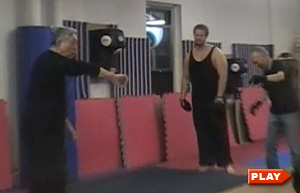
A snake is fast because it's soft. (00:03:03)
Just make the "memory shape"!
In studying the hook, Grandmaster Chen advises students not to try to hit hard or penetrate the target.
He explains that a snake strike is so quick because it's soft and focuses on moving its teeth accurately.
Its body just follows along.
For a hook, you just flip over the fingers and make the shape.
The toe spins the inner thigh.
(Application class, 2010)
From: William C. C. Chen
To watch, click on picture

Maintain "gorilla shape". (00:01:47)
Knees close on activation of the toe and legs.
Grandmaster Chen explains the details of generating a strong hook.
The elbow stays in space and doesn't pull back.
You take on a "gorilla shape" in the relationship between chest, shoulders, and arms.
To generate power requires a serious intention ("I want to kill you").
(Application class, 2010)
From: William C. C. Chen
To watch Grandmaster Chen's class, click on picture
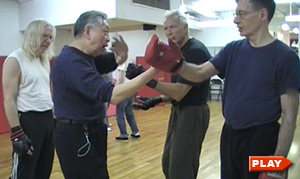
Turn the wheel. Don't push. Just get there. (00:23:24)
Grandmaster Chen teaches a strike against two opponents.
The axis is the "positive" hip, over the leg doing the punch.
The hook curves downward with the elbow up. Roll in.
Think about turning a big wheel.
Use the inner thigh and maintain rounded gorilla shape of the shoulders.
(Application workshop, 2009)
From: William C. C. Chen
To watch, click on picture